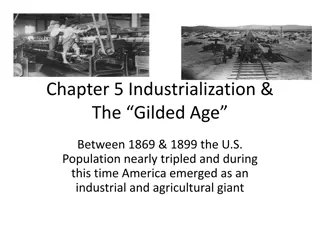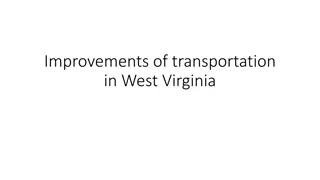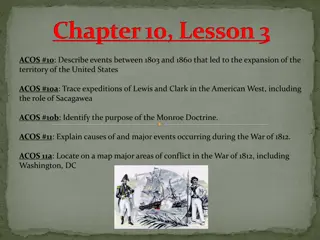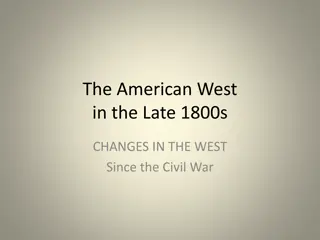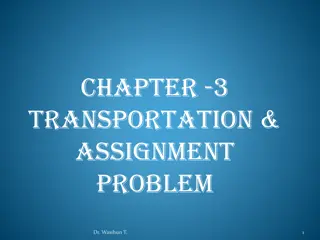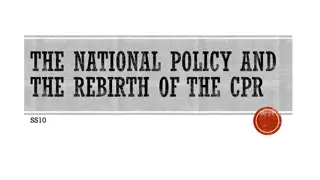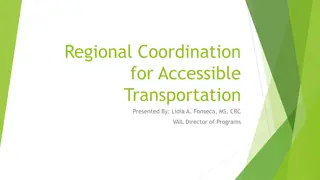Westward Expansion and Transportation Innovations in 19th Century America
Settlers moved westward into Illinois and beyond the Appalachians in the 1800s, leading to a significant population growth in the United States. Improved infrastructure such as roads, turnpikes, river travel, steamboats, and canals played crucial roles in facilitating transportation and trade during this era of westward expansion.
Download Presentation

Please find below an Image/Link to download the presentation.
The content on the website is provided AS IS for your information and personal use only. It may not be sold, licensed, or shared on other websites without obtaining consent from the author.If you encounter any issues during the download, it is possible that the publisher has removed the file from their server.
You are allowed to download the files provided on this website for personal or commercial use, subject to the condition that they are used lawfully. All files are the property of their respective owners.
The content on the website is provided AS IS for your information and personal use only. It may not be sold, licensed, or shared on other websites without obtaining consent from the author.
E N D
Presentation Transcript
Westward Bound Chapter 10 Section 2
Moving West Settlers began pouring into Illinois and continued west of the Appalachians during the 1800s. Frontier families would move from place to place as the line of settlement continued to push west. The first census was done in 1790 and it revealed that the population of the United States was nearly 4 million. Near that time, most people lived east of the Appalachians and only a few hundred miles from the Atlantic. Within a few decades this changed to where a number of settlers heading west increased dramatically. By 1820, the population had doubled to about 10 million with 2 of those living in the west.
Roads and Turnpikes The nation needed good roads to be able to travel on and for the shipment of goods. Private companies built turnpikes which helped with the payment of these roads. The roads had a base of crushed stone and the land was muddy in some areas. Some companies built corduroy roads to help. When Ohio became a state in 1803, they asked Congress to make a road connecting them with the east. Congress agreed and construction began in 1811. The road was completed in 1818.
River Travel River travel had definite advantages over travel by wagon and horse. It was a lot more comfortable and boats could carry larger loads of farm products or other goods than a wagon. River travel had two problems. 1) result of the geography of the eastern part of the USA. Most major rivers flowed in the N/S direction not E/W. 2) travelling upstream by barge against the current was extremely difficult and slow. Steam engines were invented by James Rumsey and he equipped small boats in quiet rivers but they were never strong enough to withstand the strong currents and winds in large bodies of water. Robert Livingston hired Robert Fulton to develop a steamboat that could carry cargo and people up the Hudson River.
Continued Fulton was ready for his test trial in 1807. He designed a new engine that powered the boat. His boat would be called the Clermont and it successfully made the 150 mile journey to Albany in 32 hours. The Clermont offered great comfort to the passengers and even though the engine was noisy, the ride was smooth. Steamboats greatly improved the transport of goods and passengers along major inland rivers. Regular trips happened up the Mississippi. Shipping became cheaper and faster. They also contributed to the growth of cities and by 1850, there were 700 steamboats who carried passengers and cargo.
Canals Steamboats depended on the existing river system and all major rivers in the east flowed north and south. Steamboats could not effectively tie the east and west to the rest of the country. De Witt Clinton and officials developed a plan to link NYC with the Great Lakes region. They would build a canal across New York state. It would also connect Albany on the Hudson with Buffalo and Lake Erie.
Building the Erie Canal Thousands of laborers worked on the construction of the 363 mile Erie Canal. They built a series of locks along the canal because these provided a way to raise and lower boats at places canal levels changed. Construction was dangerous for the workers. Diggers were buried when canal beds collapsed and others died in blasting accidents. The swamps also led to disease. After over 2 years, the canal was opened on Oct. 26, 1825. Crowds cheered as it worked.
Improving Canal Travel In the beginning, steamboats could not go up the canal because they could damage the embankments. They would have to use horse and mule to haul the boats and barges. In the 1840s, the canal banks were reinforced to accommodate the steam tugboats that could pull the barges. The success of the Erie Canal led to an explosion in canal building. By 1850, the USA had more than 3600 miles in canals. They finally linked the regions of a growing country.
Western Settlement Americans moved west in waves. The first wave began before the 1790s and led to the admission of 4 new states between 1791- 1803. They were Vermont, Kentucky, Tennessee, and Ohio. The 2ndwave began in 1816-1821.Indiana, Illinois, Mississippi, Alabama, and Missouri were created. New states reflected the dramatic growth of the region west of the Appalachians. It went from 387,000 to 2.4 million people. Pioneer families settled along the rivers and created their own communities. They did not have all the stuff that the East did, but they created new lives for themselves and their families.





